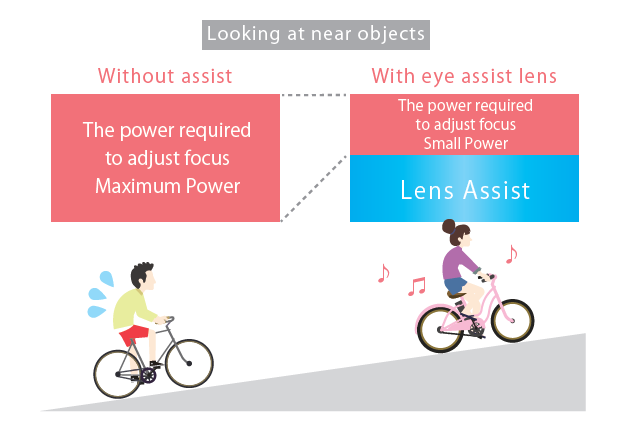In this Article (4), we would like to give some advice about the selection of eyeglass lenses for people in their 60s and over, and this is the final article concerning “eyeglass lenses for smartphones.”
For information about the selection of eyeglass lenses for people in their 20s to 50s, please see the following:
- Vol.7 Eyeglass lenses suitable for smartphones (1) (for people in their 20s, 30s, and early 40s)
- Vol.8 Eyeglass lenses suitable for smartphones (2) (for people in their late 40s)
- Vol.9 Eyeglass lenses suitable for smartphones (3)(for people in their 50s)
See the illustration below, which was used in Article (2) above.

We use the expression “generally” here because there is a difference between individuals, and the power to adjust focus further deteriorates from the age of 60, and the distance at which the eyes of people in their 60s and over can adjust focus to near objects with vision correction is “2 meters.” In this state, even if maximum add power (power to adjust focus to near objects) provided by progressive lenses or progressive power lenses for near/middle vision or middle/near vision is added, it is difficult for the eyes to adjust focus to a distance of “20 cm.”
Recommendations to people in their 60s or over
Considering the abovementioned facts, we recommend changing to lenses “tailored to near vision,” or “wide vision lenses for near vision,” not progressive lenses or progressive power lenses for near/middle vision or middle/near vision, as an optimum selection from the aspect of “viewing a smartphone.”
For details, click here. → Wide Vision for Near
Progressive lenses additionally require power to adjust focus, which results in a narrower field of view and increased distortion. Furthermore, the distance to which focus is adjusted ahead of objects close to hands by progressive power lenses for near/middle vision or middle/near vision gradually reduces with age, and these lenses can no longer be called “lenses for indoor use” with this distance.
In this state, lenses called “reading glasses” are generally used to do things at hand, including viewing a smartphone. However, “reading glasses” have only one point of adjusting focus (= focal point) and make it quite difficult for users “to do something while doing another thing.” If one wears reading glasses specifically tailored to “use for a smartphone” whose distance of focus is adjusted to approximately 20 cm, his/her eyes do not focus on, for example, a cup of coffee on a desk. It is also difficult to see the face of an important person next to him/her. In such a situation, the “Wide Vision for Near Lens” is effective.

Basically, progressive lenses are additionally provided with power to adjust focus when seeing near objects (= using the lower part of the lenses), whereas this “Wide Vision for Near Lens” is designed to change the focal point by reducing the power to adjust focus to near objects when seeing objects slightly ahead (= using the upper part of the lens). In addition, the right and left fields of view of the Wide Vision for Near Lens are much wider than those of progressive lenses and progressive power lenses for middle/near vision. In brief, the Wide Vision for Near Lens” is an “advanced lens for reading glasses,” which enables the user to see objects slightly ahead of his/her hands. Today, healthy life expectancy and retirement ages are rapidly rising, and many people over 60 probably use personal computers at home and in work. Since this Wide Vision for Near Lens is extremely suitable not only for viewing a smartphone but also for office work, we sincerely desire those who have such a lifestyle to try it.
However, to those who still feel the change of lenses bothersome or desire to use the same eyeglasses in all situations, we recommend lenses with a short corridor length of, for example, 9 mm as introduced in Article (2).
For details, click here. →Clair Arte
The reasons why we recommend the Wide Vision for Near Lens are that it provides a wide field of view for near vision and, what is more, it is designed to enable the user to move the line of vision downward easily. The power to move the line of vision downward (downward torsion) also deteriorates gradually with age. Against this situation, the biggest advantage of the Wide Vision for Near Lens is the easy adjustment of focus to near objects even if the movement distance is short. On the other hand, this lens has such disadvantages as intense shaking or distortion. However, of those who persistently desire to “use the same eyeglasses” in all situations, many of them have lived mainly with progressive lenses for years and can be called “advanced users of progressive lenses. Thus, they may have become used to sway and distortion. We think the Wide Vision for Near Lens is worth considering.
The reasons why we recommend the Wide Vision for Near Lens are that it provides a wide field of view for near vision and, what is more, it is designed to enable the user to move the line of vision downward easily. The power to move the line of vision downward (downward torsion) also deteriorates gradually with age. Against this situation, the biggest advantage of the Wide Vision for Near Lens is the easy adjustment of focus to near objects even if the movement distance is short. On the other hand, this lens has such disadvantages as intense shaking or distortion. However, of those who persistently desire to “use the same eyeglasses” in all situations, many of them have lived mainly with progressive lenses for years and can be called “advanced users of progressive lenses. Thus, they may have become used to sway and distortion. We think the Wide Vision for Near Lens is worth considering. On the other hand, this lens has such disadvantages as intense shaking or distortion. However, of those who persistently desire to “use the same eyeglasses” in all situations, many of them have lived mainly with progressive lenses for years and can be called “advanced users of progressive lenses. Thus, they may have become used to sway and distortion. We think the Wide Vision for Near Lens is worth considering.
To all customers
Finally, when it comes to “being annoyed with harmful rays, such as blue light,” which is one of the troubles customers complain, it is important to cut them off, needless to say. It is said that blue light has an adverse impact not only on the eyes but also on mental and physical health, including the internal body clock. We think it is no exaggeration to say that cutting off these harmful rays is an indispensable option for the current society where people have many opportunities to use a wide variety of devices. The use of eyeglass lenses additionally provided special functions, colors, and coatings is very effective in protecting the eyes from various types of harmful rays. Thus, please consider using these lenses as well.
Body-friendly care lens: LUTINA
Color:Absorptive Lens Fine Color Feel Color
Coating:BCC (Blue Cut Coating) / TBC (Technical Blue Coating)
Thank you very much for taking the time to read the long series of four articles. Although the main theme was “viewing a smartphone,” the contents may have slightly focused on some specific topics.
We hope that you will consult eyeglass stores about eyeglass lenses suitable for you based on the information introduced in the articles, as well as your eye condition and lifestyle.
It is not a stretch to say that “smartphones” are an integral part of our daily lives. 5 years or 10 years ago no one could expect that smartphones would come into widespread use and become indispensable to our daily lives to the extent seen today. In the rapidly changing environment, Tokai Optical, as an eyeglass lens manufacturer, is determined to be further committed to contributing to people’s living with comfortable vision through research and development of products that meet the needs of the times and to deliver helpful advice from this section of our website. We would appreciate it if you would continue to give us support and patronage.





